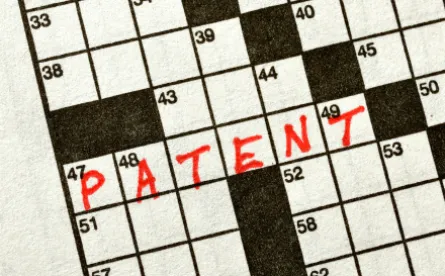Takeaway: The Federal Circuit does not have jurisdiction to review institution decisions under 35 U.S.C. § 324(e); however, it is not barred from reviewing whether a patent qualifies as a covered business method patent.
In its Opinion, the Federal Circuit held that the ’573 patent and ’440 patent qualify as covered business method (CBM) patents and affirmed the Board’s final written decision in CBM2013-00020.
In its petition to the Board, Apple asserted that claims 1, 2, 4, and 5 of the ’573 patent and claims 1, 64, and 95 of the ’440 patent were anticipated by CompuSonics. The Board instituted CBM and determined that both patents were CBM patents because they recite the electronic movement of money between financially distinct entities, and do not include features that would otherwise be excluded from CBM. Although Apple had only asserted that the patents were anticipated by CompuSonics, the Board exercised its discretion to institute review on obviousness grounds as well as anticipation grounds. SightSound argued that it had been deprived of a fair opportunity to respond to the obviousness grounds on which CBM had been instituted. The Board granted SightSound additional time for argument before rendering its final decision. In the final decision, the Board upheld institution of review on both anticipation and obviousness grounds. All of the claims of the ’573 patent and claim 1 of the ’440 patent were held to be anticipated by CompuSonics while claims 64 and 95 of the ’440 patent were deemed obvious in view thereof.
The Court began its analysis by noting that it does not have jurisdiction to review the decision on institution of CBM review under 35 U.S.C. § 324(e). However, the final decision by the Board is reviewable under 28 U.S.C. § 1295(a)(4)(A) and 35 U.S.C. § 329. In its appeal brief, SightSound alleged that the final decision by the Board should be set aside because Apple did not explicitly raise the issue of obviousness in its petitions. The Court stated that the statute does not limit the Board’s authority in a final decision to grounds alleged in the CBM petitions. Applying the reasoning of In re Cuozo Speed Technologies, which related to a similar statute in inter partes review, § 314(d), the Court determined that it lacks jurisdiction to review the Board’s institution decision.
SightSound next argued that the patents are not CBM, and thus the Board lacked the authorization to review them. First, the USPTO and Apple argued that the Court is barred from review of this question. However, the Court asserted its jurisdiction to review the Board’s determination of whether patents are CBM patents, citing Versata II. SightSound argued that its patents are not CBM patents because the invention as a whole must be directed to the management of money, banking, or investment or credit. The Court stated that Versata II already foreclosed this interpretation of the statute. SightSound also alleged that its patents recited technological inventions. However, the Court stated that a combination of known technologies does not amount to a “technological invention.” The Court determined that the Board’s reasoning was not arbitrary or capricious and that substantial evidence supports the Board’s determination.
As for the Board’s claim construction, the Court reviewed (1) the underlying factual determinations concerning extrinsic evidence of substantial evidence, and (2) the intrinsic evidence and the ultimate construction of the claim de novo. The Board determined that “second memory” would not exclude three media types based on the specification because the Board required a “clear disclaimer” to overcome the ordinary meaning of the term. The Court, applying Phillips v. AWH, stated that this was incorrect because the specification is the best guide to determine the meaning of a term. The disadvantages described in the specification, related to the three media types, amounted to an implied disclaimer of those media types according to the Court. However, the Court determined that the Board did not err in rejecting SightSound’s assertion that a floppy disk, which is mentioned in the CompuSonics reference, should be excluded. The Court also reviewed and agreed with the Board’s conclusions regarding the prosecution history in which the term “hard disk” was removed in favor of the broader term, “second memory.”
Finally, the Court determined whether the Board properly concluded that the claims would have been obvious. The Court reviewed the Board’s factual findings for substantial evidence and its legal conclusions de novo. The Board determined that SightSound conceded that the CompuSonics publications describe prior art elements working according to their established functions in a predictable manner. SightSound alleged that an ordinary artisan would not have had a reason to combine those elements. On appeal, SightSound asserted that the Board lacked substantial evidence to conclude that there was no nexus between the success of the iTunes Music Store and the claimed invention. As explained by the Court, to establish a proper nexus between a claimed invention and the commercial success of a product, a patent owner must offer proof that the sales were a direct result of the unique characteristics of the claimed invention. The Board determined that the store includes numerous inventions other than the general purchasing and downloading of music relied upon by SightSound. Further, SightSound did not provide proof that the commercial success of the store resulted directly from SightSound’s claimed invention. The Court agreed with the Board’s determination that there was no nexus between the store and the claimed invention. SightSound asserted that the Board erred in finding claims 64 and 95 of the ’440 patent obvious because of an alleged teaching away. The Court did not find any basis for the alleged teaching away and affirmed the Board’s conclusion in this regard.
SIGHTSOUND TECHNOLOGIES, LLC v. APPLE INC., 2015-1519, 2015-1160
Appeal from the USPTO, PTAB in No. CBM2013-00020
Dated: December 15, 2015
Patent: 5,191,573 and 5,966,440
Before: Lourie, Dyk, and Hughes
Opinion by: Dyk



 />i
/>i

